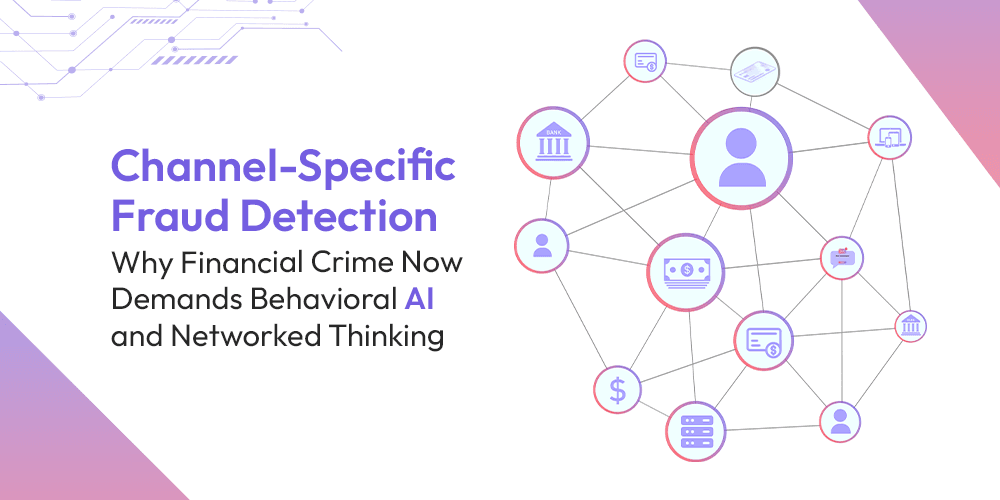
Channel-Specific Fraud Detection: Why Financial Crime Now Demands Behavioral AI and Networked Thinking
RaptorX.ai
Friday, May 16, 2025
In a world where financial transactions move in milliseconds, fraudsters have evolved just as fast—if not faster. We’re no longer dealing with one-size-fits-all scams. What we’re seeing instead is the rise of channel-specific fraud: precise, engineered attacks that exploit the nuances of each country’s financial system and payment rails.
India’s UPI scams, Zelle fraud in the United States, and cross-border laundering through the Gulf—these aren’t isolated events. They’re symptoms of a larger, systemic problem: legacy detection systems that are too rigid, too siloed, and too slow. To keep up, financial institutions must shift from static defenses to adaptive, behavior-aware systems that can see the bigger picture—across accounts, devices, channels, and borders.
The Global Fraud Landscape Is Fragmented—and That’s the Problem
India: Real-Time Payments, Real-Time Risk
India’s rapid embrace of UPI and AePS has made payments easier and faster—but also far riskier. UPI’s instant settlement is being misused for “authorized push payment” scams, where users are tricked into sending money to fake VPAs. Meanwhile, Aadhaar-based biometric authentication has become a new fraud vector. Stolen or synthetic identities are used to drain government subsidies, often leaving little digital trace.
United States: Fast Money Meets Friendly Fraud
In the U.S., platforms like FedNow and Zelle are pushing real-time payments into the mainstream. But with speed comes risk. Fraudsters test stolen credentials using micro-deposits, then execute larger thefts. Even worse, some users game the system by filing false disputes—a trend known as “friendly fraud.” Legacy systems, built to analyze history, can’t always interpret intent in the moment.
GCC: The Cross-Border Complexity
In the Gulf, open banking and wallet systems have created new fraud opportunities. Some groups launder money by simulating employee payrolls or sending layered transfers to high-risk regions. In many cases, the transactions appear completely legitimate—unless you’re analyzing them with a broader lens that connects dots across countries and institutions.
Why Traditional Fraud Detection Falls Short
1. Rules Are Too Easy to Work Around
Most banks still use static rules: flag anything above a certain amount, or from a specific region. But fraudsters have figured this out. They split large sums into smaller amounts—a tactic called “smurfing”—to avoid detection.
2. Channels Don’t Talk to Each Other
A fraud ring might start with a UPI transaction, move funds via IMPS, and launder them through a fake merchant on a card network. If systems monitor each channel separately, these steps look harmless. But when linked together, they form a clear pattern of abuse.
3. Compliance Processes Can’t Keep Up
Even when fraud is detected, filing regulatory reports (like STRs or SARs) can take days. In a world of instant payments, delays of 48–72 hours are too long. Analysts spend hundreds of hours each month just cleaning up data across disconnected systems.
What Next-Generation Detection Looks Like
This is where a more modern, intelligent approach comes in—centered on behavior, not just transactions.
Entity Linkage: Mapping Relationships
Instead of treating every account or transaction as isolated, advanced systems create “graphs” that map the relationships between accounts, devices, IPs, and more. A single device used by dozens of VPAs? That’s a red flag. These connections help uncover synthetic ID rings and mule networks that would otherwise go unnoticed.
Multi-Hop Visibility Across Channels
Money laundering doesn’t happen in a straight line. Sophisticated systems trace funds across multiple hops and time windows, detecting suspicious flows in real time—even if the transactions are spread out or appear unrelated on the surface.
Behavioral Scoring in Real Time
Detection needs to be faster than fraud. That means scoring hundreds of behavioral signals—typing patterns, device posture, biometric checks—within milliseconds. Systems must not only identify what’s happening, but how it's happening, and whether it feels “normal” for that user.
Blending Fraud and Compliance: A Smarter Approach
The most forward-thinking institutions are now blending fraud detection with compliance operations—reducing redundancy, increasing speed, and improving audit-readiness.
- Typology-Driven Alerts Fraud signals can be automatically labeled using regulatory typologies (like RBI’s for “ghost beneficiaries”), speeding up reporting and minimizing manual entry.
- Jurisdiction-Based Risk Weighting Transfers to high-risk regions automatically trigger enhanced due diligence, based on FATF guidelines. This helps banks manage geopolitical risk proactively.
- Explainability and Audit Readiness Every AI decision should come with a plain-language explanation—why it was flagged, what connections exist, and how it aligns with internal policy. This is no longer optional; regulators are demanding it.
Real Results From the Real World
- India: One private bank reduced UPI fraud losses by ₹38 crore annually after deploying entity-level analysis.
- United States: A credit union cut Zelle account takeovers by 67% in a single quarter through behavioral biometrics.
- GCC: A major bank in the UAE flagged 41 fake payroll beneficiaries tied to cross-border laundering, slashing investigation time from two weeks to six hours.
Conclusion: The Future Demands a Networked Defense
Fraud has become a networked threat. Our defenses need to match that complexity—not with more rules, but with smarter systems. Detection platforms must think in graphs, not spreadsheets; react in milliseconds, not days; and offer transparency without compromising speed.
At RaptorX, we’ve built exactly for this moment. Our platform combines behavioral AI, entity linkage, and regulatory alignment to help financial institutions stay a step ahead—detecting first-time fraud, automating compliance, and building truly adaptive resilience. Because in a world moving this fast, only systems that see the full picture will survive the next wave of financial crime.

